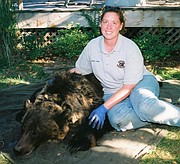Grizzly bear conflict-prevention specialist making a difference
Cabinet Resource Group (CRG), a grass-roots conservation watchdog group active since 1976 in northwest Montana, held its annual meeting Saturday, March 9 at Bighorn Lodge on the Bull River. The group uses this event every year to share issue updates with members, introduce like-minded groups in the region, give awards, and vote on board members.
Officers reported CRG has received grants to help the Kootenai National Forest by funding a full three weeks of trail maintenance crew work on both the Libby and the Trout Creek side of the Cabinet Mountain Wilderness, plus one full-time summer employee this year.
The nearly 60 attendees heard from board members about an ongoing problem of jelly-like asbestos-laden tailings behind an impoundment dam in Rainy Creek near Libby. The eight drains are all collapsing and there are other structural worries.
More than 400 people have died of asbestosis, and another 2,000-plus are still sickened from exposure, in the Libby area. The mine company, W.R. Grace, has spent about $500,000 removing toxic asbestos from the town’s topsoil, homes and other buildings. This part of the project is winding down and Montana’s Department of Environmental Quality (DEQ) will be taking over management of it from the federal Environmental Protection Agency (EPA).
EPA decided to leave cleaning up Rainy Creek, which will be much more expensive, until last. Alternatives proposed by W.R. Grace for removal of the asbestos from the creek have so far been for short-term, such as building a second dam that might last at most thirty years, the least expensive option. Mine reclamation experts were cited as having determined that “it’s not a matter of if, but when” the tailings dams fail, causing around 3.5 million cubic yards of toxic asbestos to wash into the Kootenai River. Discussions with EPA are ongoing regarding options for removing the material.
KEYNOTE SPEAKER Kim Annis, Montana FWP Grizzly Bear Management Specialist for the Cabinet-Yaak Ecosystem (CYE), discussed the Human-Bear Conflict Prevention Program she is responsible for in Sanders and Lincoln counties. The CYE is the smallest grizzly recovery area in Montana and has only about 55 grizzlies, compared with 800 to 900 plus, and over 1,000 in the Greater Yellowstone and Northern Rockies Ecosytems respectively. Even with over 70% of the CYE in public land, bear/human contacts occur.
Annis’ job is to reduce unnecessary grizzly mortality and maintain public support for grizzly bear population recovery by helping people minimize attractants and learn how to act around bears to reduce the risks to people and to the bears. She aims to address every bear/human conflict, both black and grizzly, within 24 hours of a report. Bears are one-time learners she says, so if they get the idea that a garbage can is a food source, they need to quickly be convinced it is a bad option so that the bear does not get habituated.
“It is so much easier to prevent conflict than to resolve it once it happens,” says Annis. For this, electric fencing is “a tool with unlimited applications.” She keeps a stock of electrical fence available for loan, or can help people figure out what to purchase, to deploy around food attractants such as chickens, fruit trees, honey bees, and even freezers and garbage bins if indoor storage for those is not available. At times, she has helped fence attractants across whole neighborhoods to teach a bear to move on.





